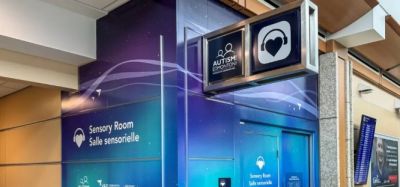Enhancing airport accessibility at Carrasco International Airport
- Like
- Digg
- Del
- Tumblr
- VKontakte
- Buffer
- Love This
- Odnoklassniki
- Meneame
- Blogger
- Amazon
- Yahoo Mail
- Gmail
- AOL
- Newsvine
- HackerNews
- Evernote
- MySpace
- Mail.ru
- Viadeo
- Line
- Comments
- Yummly
- SMS
- Viber
- Telegram
- Subscribe
- Skype
- Facebook Messenger
- Kakao
- LiveJournal
- Yammer
- Edgar
- Fintel
- Mix
- Instapaper
- Copy Link
Posted: 17 December 2024 | | No comments yet
Federico Cabrera, Operations and Experience Manager at Aeropuertos Uruguay, explains for International Airport Review, what they are doing to ensure a fair and accessible travel experience for all.


Above: Carrasco International Airport. Credit: Carrasco International Airport
At Carrasco International Airport, we are committed to providing a seamless and barrier-free experience to all passengers. Making our airport universally accessible is a pillar of our work, as we are dedicated to providing the same level of excellence, comfort and attention to everyone.
The main aspect of our strategy is our firm belief that accessibility is not a specific action or campaign, but is a fundamental human right, and thus it is a lens through which we should look at every decision we make. This is why it is transversal to every area and project we undertake.
Accessibility strategy
One of the first things that became clear right away for us when thinking of our accessibility strategy was the need to have expert advice. Particularly to have the authentic insight and feedback of individuals with unique needs and disabilities. It was important for us to have a real understanding of their experience in our airport, to see from where we were starting off and what the journey ahead looks like.
We acknowledge that as an airport we are in a unique position to be a catalyst for change
We partnered with an accessibility focused consulting firm, to conduct a comprehensive analysis of our situation in terms of accessibility. This encompassed a thorough look into our architecture, our services, our communication, our tools, and our processes, including interviews and visits with people with disabilities, consulting experts, conducting surveys and more, to understand our strengths and identify improvement opportunities.
This helped us develop a strategic master plan with short-, medium- and long-term actions to work towards our goal. It also sparked an internal grassroot movement within our workers. We were proud to see them take ownership in proactively moving the issue forward.
Make it official
Among the actions that we took right away were to officially declare accessibility a strategic focus for our airport, creating an accessibility policy and setting up an accessibility committee formed by representatives of every area. Their task, as it is an ongoing committee, is to ensure that accessibility is a key evaluation criterion for every project. We also took a wide range of more operational focused actions geared towards our passengers, and also our staff.
A fundamental element of our strategy was to ensure that our customer experience people understood the importance of accessibility. This is why we provided training to all our operation staff, hand-in-hand with the consulting firm and with people with disabilities who shared with our teams their perspective and the unique challenges faced. It was also an opportunity to prepare every customer experience officer to help ensure we are always delivering a respectful and inclusive experience for all.
Another essential factor of our overall commitment is to make sure that there is complete coherence between what we do externally and what we do internally. This means we are always working towards enhancing labour inclusivity, as we create an accessible work environment for all employees, including team members of varying abilities.
We acknowledge that as an airport we are in a unique position to be a catalyst for change, and to bring together the different actors in the travel ecosystems towards inclusivity as a shared goal. We joined the National Accessible Tourism Board, a collaborative effort, involving government agencies, industry stakeholders, and disability groups. It helps us align our efforts with the latest accessibility standards and with other actors of the industry to ensure the entire journey of a traveller, from the airport, to the hotel, the museums, and beaches become accessible.
Never stop improving
Accessibility is not a goal but a continuous journey of improvement to us. We are convinced that our work has only just begun, and we have lined up many more projects in the coming months and years, to keep improving. Our next steps include deepening our understanding and work with non-visible disabilities, aligning the entire airport community and going through every process with the focus of accessibility in mind.
By fostering strong partnerships with our stakeholders, engaging with diverse communities, and leveraging expert guidance, we are committed to creating a more inclusive and welcoming environment for all travellers.
About the author


Federico Cabrera
Federico Cabrera holds a bachelor’s degree in international trade (Magna Cum Laude) by UDE University, Montevideo, Uruguay. He has over 25 years of experience in private sector and always in major companies in the services industry. In 2012, he joined Carrasco International Airport as a Procurement Manager, moving in 2016 to Operations, first as Passenger Experience Manager, and then in 2020 as Operations and Passenger Experience Manager in Aeropuertos Uruguay. In the last seven years, Cabrera has led the transformation of Carrasco International Airport in a passenger-centred airport, over the Easy Airport project, reaching impressive goals. Cabrera is Vice-Chair of the ACI World Facilitation & Services Standing Committee and member of the ACI LAC Security, IT & Services Standing Committee.
Related topics
Accessibility, Airport development, Equity, Diversity & Inclusion (EDI), Passenger experience and seamless travel, Passengers with reduced mobility (PRMs), Social responsibility, Sustainability, Terminal operations
Related airports
Related organisations
ACI LAC (Airports Council International Latin America & Caribbean), ACI World (Airports Council International), Aeropuertos Uruguay, National Accessible Tourism Board


















